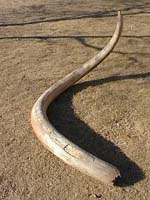Hunters find mammoth tusk in Alaska
Caribou hunters have recovered a 7-foot, 3-inch (2.20-meter) mammoth tusk from a creek bed in Alaska.

The Ice Age specimen was spotted by Mickey Paneak, 36, in Manu Creek close to the village of Anaktuvuk Pass, Alaska, as he and his cousin Mike Morry, 33, ran after two wounded caribou.
Jumping over the creek, Paneak noticed something in the creek's shallow bed.
"The base of the tusk was sticking straight up and its midsection had moss on it," Paneak said.
The men removed the tusk from the creek bed and carefully transported it to the village about 250 miles (400 kilometers) northwest of Fairbanks.
"It took two of us to carry it," said Paneak, who estimated the tusk's weight at more than 150 pounds (70 kilograms).
The tusk now rests on Paneak's porch, where it will be scrutinized by scientists while its future is decided, reports AP.
The glacier chronology in the Anaktuvuk Pass area has a complex history of advancing and retreating at the end of the Ice Age about 10,000-12,000 years ago, and the tusk could be from a mammoth of that era. Mammoths are believed to have become extinct about 10,000 years ago.
The tusk could also be from an older mammoth, dating back 30,000 to 100,000 years ago during a relatively warm period when glaciers had retreated.
Subscribe to Pravda.Ru Telegram channel, Facebook, RSS!


